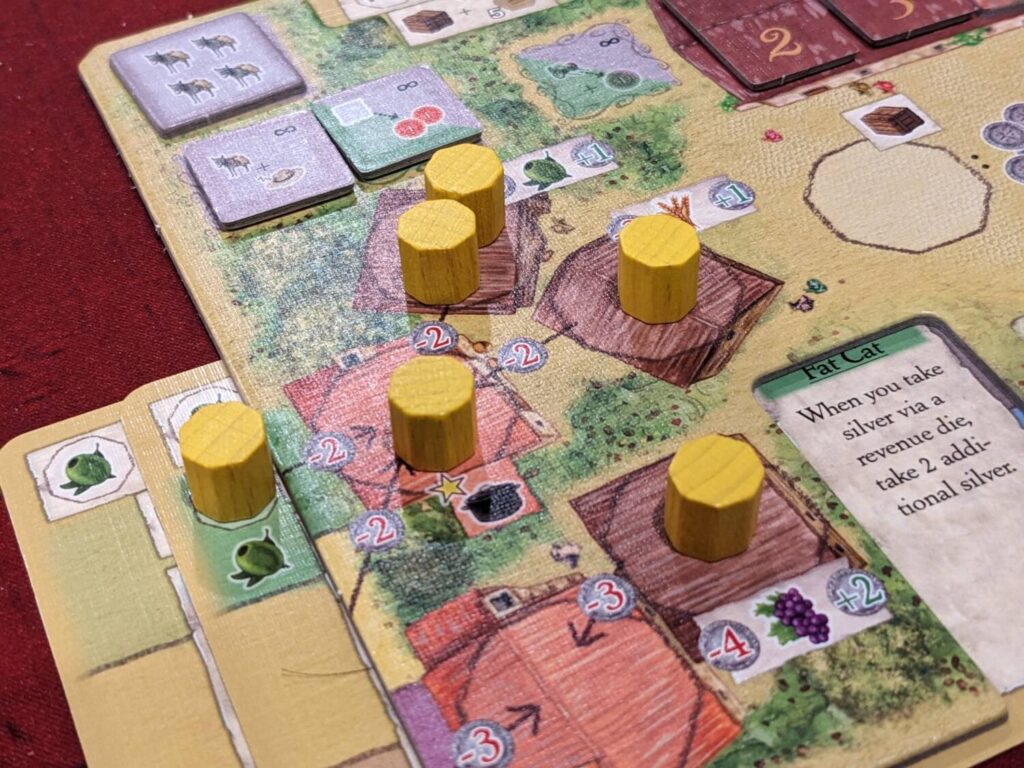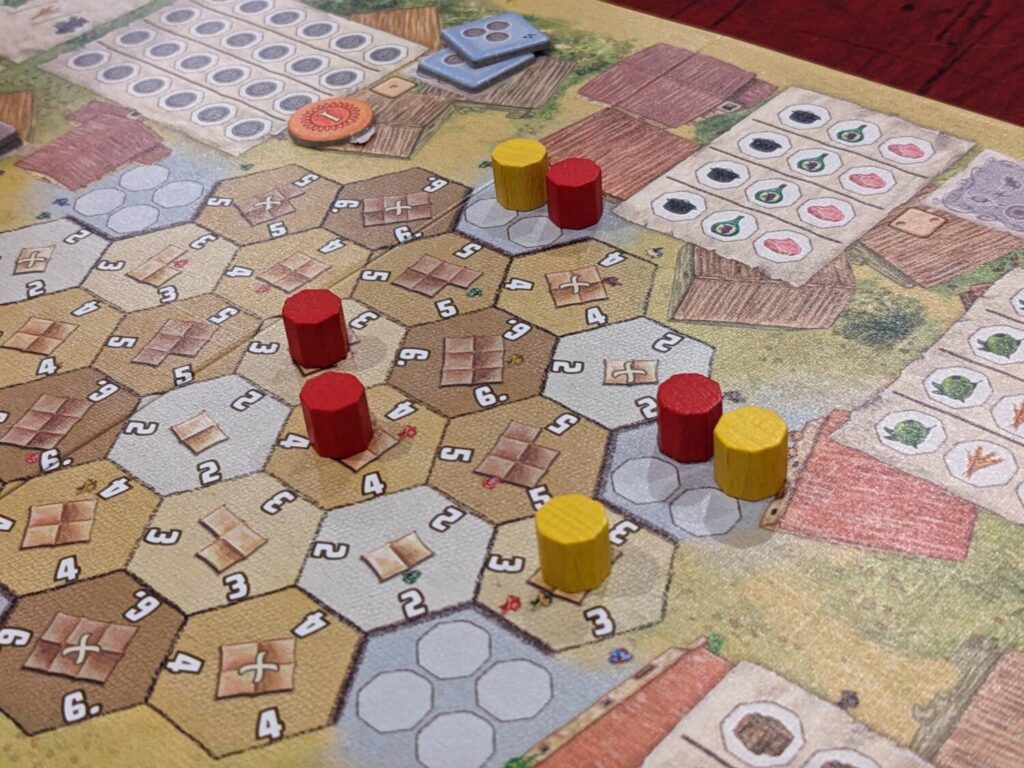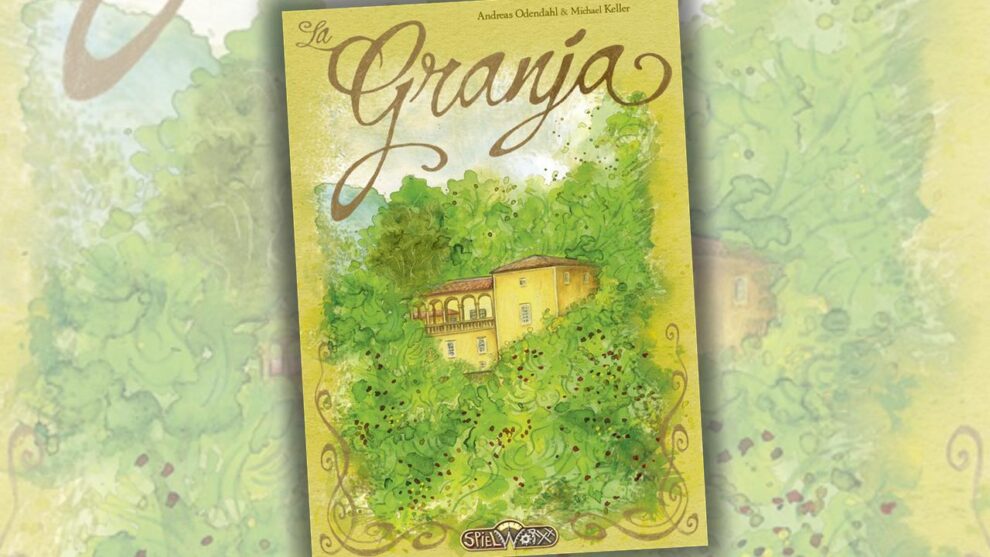Here at Meeple Mountain, we love a good project.
Longtime hobbyists know that the “slow time” in our space is usually the first 3-4 months of any calendar year, before publishers start to hype new games for the convention season that begins in earnest with the UK Games Expo before the other big shows hit over the summer and into early fall.
That means that the writing team needs different reasons to get new games to the table. What better way to attack that idea than to consider the games that players rate so highly? A number of us are going through our old collections to write about the games we haven’t already covered, so I took some time to get La Granja (2014, Spielworxx / Stronghold Games) to the table for a few plays both “IRL” (in real life) and on Board Game Arena, where an implementation has lived for almost five years.
I got my physical copy of La Granja in a math trade a couple years ago. The previous owner had removed the shrink but never punched the game, so it was kinda wild to break open an 11-year-old game and punch it for the first time. The Stronghold edition of La Granja is bare bones—small hexagonal cylinders that are used to represent almost everything in the game, from pigs to olives to wine to “imported goods” to trackers that are used on the craft buildings.
While my copy is the original, I actually played the deluxe version, published by Board&Dice, at a friend’s house a couple years ago. That was my first play, and I have to say: La Granja has aged exceptionally well. That’s because the game’s systems are so easy to teach to an experienced gamer—heck, even inexperienced players like my kids can pick up the systems—and the playtime is snappy. With 2-3 players, you can knock out a game of La Granja in about an hour and make a number of really interesting decisions along the way.

Baby, Those Cards!
La Granja is a 1-4 player economic medium-weight strategy game that has a lot of different mechanics melded into a very digestible format. Players are managing a farm (although thankfully from a weight perspective, not this kind of a farm) while trying to score the most points over a breezy six-round turn structure. La Granja is Eurogame potpourri: there’s area control, dice drafting, multi-use cards that are used to produce field resources, double as variable player powers, triple as order fulfillment cards, and quadruple as “farm extension” cards that can expand your farm in unique ways each game. The game also features a small array of other simpler mechanics including “anytime actions” where players can manipulate their farm as needed on a given turn to offer manageable combo opportunities.
The La Granja package is quickly becoming the kind of joy that makes me upset that I sat on my copy of the game for so long.
Turns offer players a chance at light-to-medium crunch on every action. The game’s six rounds are broken into four phases each. During the Farm phase, players collect income, add a new card to their farm (a personal player board that also becomes their individual card tableau), and buy one-time-use Roof tiles that cost an amount of silver coins equal to the current round number.
Then dice get chucked in the Revenue phase—one six-sided die, plus two more six-sided dice per player (so, in a four-player game, nine dice in total). The rolled results are then placed next to the matching pip result, one of six different actions shown along the left side of the main board, such as farm resource collection, cash, or upgrades of a resource from its raw form to its cooked/distilled form (so, olives into wine, pigs into stew, etc.).
Even across these first two phases, there’s just enough to consider to be interesting but not take a lot of time. All of the game’s 64 cards have the four uses highlighted above. But from a hand of three cards (to start), you can only play one card during each Farm phase. That gives you 12 choices right out of the gate—three cards, four uses per card. What are you going to do? Each card’s “helper” ability becomes an ongoing player power, and all of the powers are situationally strong. You can have three active helpers at a time…but naturally, you’ll want all of those powers!
Sometimes, players will use cards to become market barrows, which are contracts played to the top of your personal farm board that can be fulfilled with the right mix of resources. Once completed, the cards score a number of points (2-6), but also reward the player with a Trade Commodity, which is the most powerful single resource in the game. As a free action, it can be converted into almost anything else—an extra card play, a good that can be delivered to the main board, two different farm goods, or even a pig!
But all of those early choices can be made in the blink of an eye while still providing just the right amount of tension. Ditto for the Revenue dice phase, where players have a limited pool of rolled dice to draft. Once each player drafts two dice (one at a time, in turn order), there will always be one leftover die at the end of this phase. That leftover die will be used by all players to get whatever benefit shown by the pips on that die.

Even that turns into a fun strategic choice, as you narrow the available choices for opponents while also trying to grab the things that you need. (Blocking an opponent doesn’t hurt either.) I loved having control over the final die choice when last in turn order, to ensure I got exactly what I wanted while hopefully hosing an opponent hoping for a different outcome.
The back half of each round, the Transportation phase and the Scoring phase, is just as juicy as the front half. That’s because the bulk of the game’s points come from delivering goods to either the cards you’ve slotted in your player board, or in one of six craft buildings. In a fun twist, producing resources in La Granja is actually quite easy; one can either get new goods from their fields (also cards that are slotted throughout play) every round during income, or they can just spend coins.
So that lets players focus not as closely on how to get goods, but instead focus on where to deliver those goods and how to score the most points. The craft buildings use a cool scoring mechanic: when a player finishes delivery in one of those areas, they score points equal to the round number. In other words, the points bounty is larger the later a player closes out a section of the main board. But going earlier creates something possibly better—a “craft marker” that increases income between rounds or boosts bonus effects when certain actions are taken.
I’ve seen this part of the game create so many different scenarios, even in just the seven games I’ve completed of La Granja (four IRL, three on BGA). One of the craft markers increases coin income by three coins, in a game where money is really tight. But even getting that marker requires the payment of six coins as deliveries before you get that bonus, which makes it essentially impossible to do in the first round without some of the helper powers. Another complication: only three of the six craft areas are open to begin the game, with the other three only becoming available as players slowly complete deliveries to the craft areas already open.
So, your options during the Transportation phase include delivering to craft buildings, covered above. When a player fulfills a market barrow, a marker is placed on a central area of the board representing the value of the filled market barrow. This central area acts as a majority control section, where players want to fill barrows with the highest value to bump lower-value markers owned by opponents off the board.
That’s because each player scores one point per peg at the end of the Scoring phase. So there’s a lot of jockeying for points income, knocking the leader out of the way to ensure they don’t get a steady helping of points every round. But filling low-value orders still garners points and trade commodities, and I’ve never complained about having too many trade commodities since they offer so much flexibility.

The One-Hour Euro Is Still a Beaut
La Granja is one of the great examples of a game right at the apex of the term “the juice is worth the squeeze.” With only six rounds, every decision matters. I’ve been surprised at how many different ways the game can be attacked and lead to a competitive outcome. Strategies focused on cards as market barrows, or fields, or helpers, or farm extensions are each viable in the right hands. Deliveries are so important to maximize; I’ve now played a couple games online where I’ve seen very seasoned players squeeze every ounce out of their coins in a round to ensure they get goods placed on craft buildings and market barrows to fire up their engine to make the back half of each game a bonanza.
And while the experienced players at the table have usually been the ones to win, the games have almost always been close. Scores in my plays have ranged from the high 40s to the low 80s so far, but in each game, I have been surprised that there has never been a runaway leader. New players to La Granja (who are also experienced gamers in general) have always fielded competitive scores, even in defeat.
The combination of revenue die rolls and specific cards drafted during play force tough decisions but everyone has to live with the limits created by a particular game. This was especially true in the games where fewer fours and sixes were rolled, because those are the revenue die results tied to getting coins from the supply.
A four-player game of La Granja with four new players might take as much as two hours, but that would only be true in the hands of very deliberate, slower turn takers. Usually, La Granja is in long filler territory, especially with three quicker players. Because La Granja is so easy to set up, teach, and teardown, you could start a night of heavier Euros with this one and leave very satisfied.
La Granja’s deluxe edition (the Board&Dice version referenced earlier) is quite a looker, but my peasant-level retail version from 10+ years ago is totally fine. Of course I wish that my player boards were not already warping, that my craft marker tokens looked fancy, or that the dice weren’t so bland. But you can find a used copy of the original game via a host of online sources, your local game store, or a math trade like I did, and I think you’ll be able to look past the production quality to find a game that focuses on all that really matters: the gameplay.
La Granja will now reside on the shelf with the other greats in my plays-in-about-an-hour, medium-weight Euros like Lorenzo il Magnifico, Coimbra, Galileo Project, The White Castle, and The Red Cathedral. I’ll play La Granja any time!











Add Comment